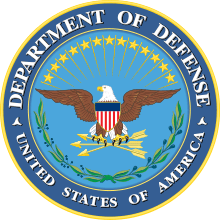Defense Commissary Agency
|
DeCA Seal | |
|
Cornucopia Logo | |
 Flag of the Defense Commissary Agency | |
| Agency overview | |
|---|---|
| Formed | 1990–91 |
| Headquarters | Fort Lee (Virginia) |
| Agency executive |
|
| Website |
www |
The Defense Commissary Agency (DeCA), headquartered at Fort Lee (Virginia), is an agency of the United States Department of Defense (DoD) that operates more than 245 commissaries worldwide. American military commissaries sell groceries and household goods to active-duty, Guard, Reserve, and retired members of all seven uniformed services of the United States and eligible members of their families at cost plus surcharge, saving customers an average of more than 30 percent compared to civilian supermarkets.[1]
History

The commissary benefit is not a recent innovation. Sales of goods from commissary department storehouses to military personnel began in 1825, when U.S. Army officers at specified posts could make purchases at cost for their personal use; by 1841, officers could also purchase items for members of their immediate families.[2]
However, the modern era of sales commissaries is considered to have actually begun in 1867, when enlisted men received the same at-cost purchasing privileges officers had already enjoyed for four decades. No geographic restrictions were placed upon these sales; the commissary warehouse at every Army post could become a sales location, whether they were located on the frontier or near a large city. From the start, commissaries were meant to take on-post retail functions out of the hands of civilian vendors and post traders and allow the Army to "care for its own." The stores provided wholesome food beyond what was supplied in the official rations, and the savings they provided supplemented military pay. The modern concept of commissary sales stores, which were established to benefit military personnel of all ranks by providing healthful foods at cost, reached its 148th anniversary on July 1, 2015.[2]
The commissary retail function developed and grew, roughly parallel to the development of the retail grocery industry. The commissaries’ 82-item stock list of 1868 was comparable to the stock assortment in a typical civilian dry goods grocery store at that time. Commissaries kept pace with developments in civilian supermarkets, and the average commissary today has more than 12,000 line items; the largest stores have several thousand more.[2]
The list of eligible shoppers has also grown. Originally, only active-duty Army personnel could shop. Today, personnel in all services, including the Coast Guard and National Guard and Reserves, may shop in the commissary on any U.S. military installation, around the world. Military retirees – those who have served in uniform 20 years or more – were first allowed to make commissary purchases in 1878, and they continue to have shopping privileges. Spouses and dependent children of service personnel are authorized commissary privileges, as are recipients of the Medal of Honor, and veterans honorably discharged from service with 100% disability in connection with military service also have authorized commissary privileges.[2]
As the role of the American military grew larger, commissaries began to spread around the world. The first overseas stores opened in Cuba, the Philippines and in China between 1898 and 1904. They were soon followed by commissaries in Panama and Puerto Rico. Eventually, all the services adopted the Army's concept of commissary sales stores and tailored the concept to their own needs. The Navy and Marine Corps opened their first commissaries in 1909 and 1910, and the Air Force inherited its stores from the Army Air Forces in 1947 and 1948. By the mid-1970s, each of the services ran its own commissary agency, with differing procedures and systems: the Army Troop Support Agency (TSA), the Navy Resale System Support Office (NAVRESSO), the Commissary Section of the Marine Corps Services Command, and the Air Force Commissary Service (AFCOMS).[2]
Separate systems combined
In 1989, Congress directed DoD to conduct a study of the separate military commissary systems. The ensuing report by the Jones Commission (headed by Army Lt. Gen. Donald E. Jones) recommended consolidating the service systems into one agency to improve service and save money. The Defense Commissary Agency (DeCA) was established May 15, 1990, by a memorandum from the deputy secretary of defense; this was the first DoD functional agency consolidation during the post-Cold War cutbacks and downsizing.[2]
DoD appointed Army Maj. Gen. John P. Dreska as the agency's first director in June 1990. Shortly afterward, a transition team of commissary functional experts managed the consolidation of all the service systems into a single agency, and DeCA assumed full control of all commissaries on Oct. 1, 1991 at its headquarters in Fort Lee, Va.[2]
After leading DeCA through its initial year of operation, Dreska retired in 1992, and Army Maj. Gen. Richard E. Beale Jr. became the new director. Beale retired from the military Sept. 30, 1996, but stayed on the job as the first civilian director of the agency. He was succeeded by Air Force Maj. Gen. Robert J. Courter Jr. (November 1999 to August 2002) and Air Force Maj. Gen. Michael P. Wiedemer (August 2002 to October 2004). Patrick B. Nixon, who served as director and CEO from October 2004 to October 2007, was the first person in U.S. history to become director of any commissary agency after beginning his career at store level and steadily rising through the commissaries' civilian career field. Following Nixon's retirement, Richard S. Page served as acting director until the arrival of director and CEO, Philip E. Sakowitz Jr., in June 2008. Thomas E. Milks was acting director and CEO, from Sakowitz's June 2010 retirement[2] until Joseph H. Jeu succeeded Sakowitz 3 June 2011.[3][4]
Authorized commissary patrons
Authority to shop at Commissaries is normally determined by presentation of the U.S. Uniformed Services Privilege and Identification Card or a Common Access Card. At some military bases authorized patrons are allowed to bring guest into the commissaries. Guest are not authorized to make commissary purchases, and patrons are not permitted to make commissary purchases for guest. Base commanders can order the restriction of guest to the commissaries.
Commissary privileges overseas are covered under Status of Forces Agreements (SOFA), Visiting Forces agreements, treaties, etc. Since products sold in overseas commissaries pass across international borders and are customs, duty, and tax free; there are shopping restrictions.
Authorized patrons
- Active duty members of the U.S Armed Forces.
- Members of the Reserve and National Guard.
- Retired members of Active Duty, Reserves, and the National Guard.
- Retired Reservist and National Guardsmen not yet age 60 (Gray Area).
- Honorably discharged veterans with 100 percent service-connected disability certified by the Department of Veterans Affairs (VA).
- Recipients of the Medal of Honor.
- Civilian employees of the Department of Defense.
Eligible dependents
- Spouses of Military Servicemembers, Military Retirees, Recipients of the Medal of Honor and Veterans with 100 percent service-connected disability are entitled to full commissary privileges.
- Children until their military-parent leaves the service (without a full combat related disability) or they reach the age of 21 or age 23 if enrolled in college full-time.
Survivors
- Spouses of fallen Servicemembers in combat have unlimited commissary privileges.
- Unmarried children of the deceased servicemembers in the line of duty may use commissary privileges, until they are twenty-one, or twenty-three if enrolled in a full-time course of study in a secondary school or in a full-time course of study in an institution of higher education.
Personal agent
Authorized Commissary patron may designate an agent or representative, on a temporary basis not to exceed one year, to accompany and assist an authorized patron to the commissary under the following conditions:
- In extreme hardship cases.
- When no adult dependent member is capable of shopping due to injury, illness, incapacitation or being stationed away from their household (i.e. deployment, TDY, school, training).
- Any person chosen by a blinded or other severely disabled eligible patron to assist the patron.
The personal agent will be provided official agent credentials or an approval letter, and then may enter any commissary to shop on behalf of the authorized patron. Only an installation commander can authorize agent privileges.
Guard/Reserve On-Site Sales
Guard/Reserve On-Site Sales is a program that allows Guard/Reserve members and their families, and any authorized shopper living long distances from a commissary store. The sales which provide patrons savings of 30% or more; the same as active duty military personnel that shop regularly at the commissaries. Guard/Reserve On-Site Sales are held at Reserve Centers, National Guard armories and Air National Guard bases.
Commissaries today
Commissaries still sell products at cost today as they have since 1825. Today's customers also pay a surcharge on their purchases, which was mandated by Congress in 1952 to make commissaries more self-sustaining. The surcharge, which has been set at 5 percent since April 1983, provides modern shopping facilities for service members at a reduced cost to taxpayers. Unlike a tax, surcharge funds go right back into the commissary to work for commissary customers, paying for the cost of building new stores, renovating and repairing existing ones and purchasing equipment and store-level information technology systems such as cash registers.[5]
Commissary patrons worldwide save an average of more than 30 percent on their grocery bills.[6] In 2010, DeCA announced that the average family of four saves more than $4,400 per year by shopping regularly at a commissary, based on Consumer Expenditure Survey and U.S. Department of Agriculture statistics for household consumption of retail grocery store products.[7] Customers can use manufacturer's coupons to save even more on their commissary purchases. Annual sales now exceed $5 billion.[8]
Surveys consistently rate the commissaries as one of the military's top nonpay benefits. Many young service families, particularly those stationed in high cost-of-living urban areas, simply could not make ends meet without the price savings provided by the commissaries. DeCA has delivered more than $2 in savings to customers for every taxpayer dollar used to support the commissary system.[8] In other words, preserving this level of compensation in direct dollar payments to military personnel would cost the government more than twice the current fund appropriation.
References
- ↑ "About Us". Defense Commissary Agency. Retrieved 2012-05-03.
- 1 2 3 4 5 6 7 8 "History of U.S. Military Commissaries". Defense Commissary Agency. Retrieved 2012-05-03.
- ↑ Robinson, Kevin L. (January 12, 2011). "Joseph Jeu selected next DeCA director". Defense Commissary Agency. Retrieved 2011-01-27. DeCA News Release Number 03-11
- ↑ "Joseph H. Jeu, Director and Chief Executive Officer of the Defense Commissary Agency". U.S. Department of Defense. Retrieved 2012-05-03.
- ↑ "What is the surcharge that commissary customers are paying, what is it used for and how is it factored?". Defense Commissary Agency. July 27, 2010. Retrieved 2012-05-03.
- ↑ Slamin, Millie (October 6, 2009). "Commissaries save customers billions of dollars" (PDF). Defense Commissary Agency. Retrieved 2012-05-03.
- ↑ "Savings! Savings! Savings! - How much can you save?". Defense Commissary Agency. Retrieved 2012-05-03.
- 1 2 "Annual Report 2010" (PDF). Defense Commissary Agency. June 29, 2011. p. 2. Retrieved 2012-05-03.
External links
| Wikimedia Commons has media related to Defense Commissary Agency commissaries. |



